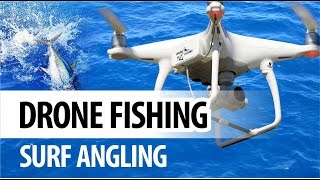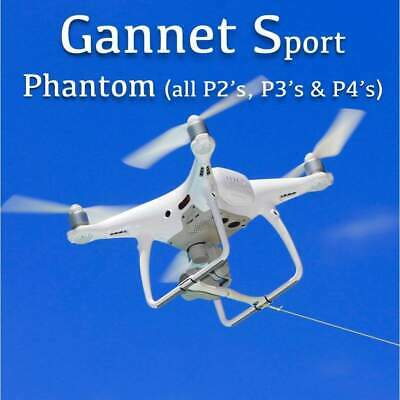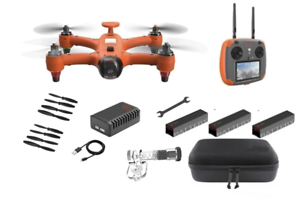
If you are a passionate fisherman, and you live in Australia you can use a drone for an aerial view of your property's waters. The drones can be equipped with a variety of features, including a GPS positioning system, a GPS receiver, a GPS receiver, a GPS payload release, and an angle adjustable camera. There are also fishing lines available that can be used for fishing. They are very stable and secure. One example is the SKY RIGGER drone.
SKY RIGGER drone fishing line
The SKY RIGGER allows you to fish remotely from your drones using a flexible fishing line system. The system features two rotating leg clamps that can attach to various drone models. The release mechanism features a bayonet-style connection, and a cam lock arm that allows you to quickly open the line clamps. Unlike other drones, the Sky RIGGER requires no batteries and can accommodate all fishing techniques safely.
For when a fish strikes your fly, the SKY RIGGER features an automatic release mechanism. The line can be manually released by either your rod or hand. This feature is included on all models. It is highly recommended that you buy a Phantom 3 before buying the new SKY RIGGER. Here are some pros & cons of the new line.
It has a mechanical payload release
A drone with a mechanical payload release system is one of the most important aspects. Many of them allow anglers to quickly and easily release their fishing line. However, some models do not have a release mechanism. To remove the drone from the fishing line, the user must "yank” the line. This can be frustrating, especially for people who aren’t comfortable using their fingers to release the line.

Another important feature is its payload release mechanism. The drone's payload should be capable to release its line when the fish strikes. This method is not easy to use. You can't just pull the fish up and let it go. The DJI Phantom drone has been reported to have excellent results by many people. But, it is still not as advanced as other fishing drones.
It comes with a GPS location system
Rippton is an Australian-Dutch joint venture that specializes technology-oriented products for fishing. It was founded to improve the success rate of anglers by creating products that increase the enjoyment of fishing. Rippton’s Mobula drone comes with a GPS position system and remote release. The Mobula has the ability to hold bait at surface, provide resistance for kite clips, as well as being environmentally friendly.
It is lightweight and weighs just 3 lbs. It can fly for up 18 minutes. The GPS system is high-tech and allows for control from as far away as 2,000 miles. It has an operating range of 1000m (or half a mile) and intelligent flight modes. The point of interest feature allows it to take high-quality photos of its surroundings. You can get amazing views of fish with its high-resolution camera.
It comes with a failsafe feature
Aerokontiki's drone fisherman has a failsafe feature. It monitors the battery level, and releases the line when it is needed. In case of battery failure, it will land back on dry ground to continue its mission. It operates with industrial-grade flightcontrollers, and it can work anywhere without requiring calibration. You can also use this drone in watery areas.

FAQ
Where are Drones Banned?
The FAA has banned drones in areas near airports and stadiums. However, they do allow them to fly at night using GPS technology.
How can I keep drones from my home?
Drones are increasingly popular for home surveillance. However, they pose a threat to privacy and security. If you want drone attacks to be avoided, you can install motion sensors all around your property. These sensors will detect any flying objects that are not authorized.
Do I need special training to fly a drone?
No, you don’t need any special training in order to fly your drone. You just need a remote-control unit and basic knowledge in flight mechanics.
What type of batteries should a drone be using?
The majority of drones use lithium-ion cells. A typical drone uses between 3 and 6 volts.
Statistics
- According to Indeed, a drone pilot gets paid $25.73 per hour on average in the US. (dronesgator.com)
- According to industry research from ZipRecruiter , there are 10 cities where the typical salary for a Drone Pilot job is above the national average. (dronesgator.com)
- According to ZipRecruiter, the minimum hourly wage of drone pilots is $20. (thedroneu.com)
External Links
How To
How to Fly Drones for Beginners
A drone refers to a remote-controlled aircraft designed for aerial photography, surveillance and scientific research. The technology behind drones has been around since World War II. DJI introduced their Phantom series of quadcopters in 2010, but commercial use only began in 2010. Since then, there have been many different types of drones available, from beginner-friendly models like the Parrot AR Drone 2.0 to professional-grade multi-rotor craft like the DJI Mavic Pro.
There are many options for flying a drone.
-
Remote control – This technique uses a control device attached directly to your hands that allows you steer the drone around its flight path. There are two types of controllers available: joysticks and on/off switches.
-
Manual Control- This allows you to control your drone remotely via GPS coordinates. Follow the instructions of the app to track the exact location you want the drone go.
-
Autonomous Flight - This method involves leaving the piloting duties to the drone itself. It is basically flying autonomously and without human intervention. For the autonomous flight to occur, the drone must have a built-in camera and sensors capable of capturing images and data.
-
Triggered Flight - This method is similar to manual control, except the pilot manually sets up a preprogrammed route, and the drone follows that route until it reaches the endpoint. After the program is complete, the drone automatically returns to the ground.
-
Landing Gear - Some drones come equipped with landing gear that allows them to land safely if they lose power or run out of battery during flight.
-
Goggles-Some pilots use goggles to protect their eyes from debris during operations.
-
Camera – Some drones have cameras, which allow you to take photos or videos from up high.
-
Obstacles. Some drones can have obstacle avoidance technology that stops them from hitting obstacles.
-
Speed - Some drones reach speeds exceeding 40 mph.
-
Battery Life: Most drones have a battery life of between 20 and 30 minutes depending on how many power sources you use.
-
Range - Depending on the model, some drones can travel up to 30 miles away.
-
Power source - Some drones need an external power source, while others use internal batteries.
-
Weight - Some drones have a weight of less than 1 pound and others weigh 4 lbs.
-
Size - Drones range from small devices that fit in one's palm to large crafts that weigh more than 50 pounds.
-
Price – All drones fall into a price category. These range from expensive models that cost thousands to affordable options that start at 100 dollars.